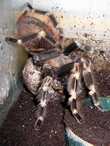Nhandu
Genus Nhandu Lucas, 1981
Genus status. Included Brazilopelma Schmidt, 1998. Synonymization by R. Raven in 1985 of this genus to the genus Sericopelma Ausserer, 1875 was not proved within the following revisions.
Species N. tripartitus Schmidt, 1997, type locality is unknown, was admited by R. Bertani in 2001 as a species with nomen dubium status.
Inclusion in this genus the species Nhandu chromatus Schmidt, 2004 is not confirmed by majority of arachnologist. Unless this taxon has reviewed here it can be easily treansfered in further revisions (see comments in "Systematic news").
Type species – Nhandu carapoensis Lucas, 1981.
Representatives of the genus Nhandu differs from other tarantulas of subfamily Theraphosinae by the absence of tibial spurs (hooks) in males, as well as from close genuses Theraphosa and Sericopelma by the structure of the male sexuals organs.
Genus is represented by 5 species (4 if Nhandu chromatus Schmidt, 2004 is not included) of big, robust and hairy terrestrial tarantulas, having one of its characteristic of hairy carapace (not shared only by Nhandu chromatus).
The average size is about 7-8 сm in body length and to 21 сm in leg span. Longelivity is supposedly not short and would be near 15-17 years.
Inhabit both humid sub-tropical and tropical forests, and area of pampases in Brazil.
All species of genus Nhandu is rather nervious, can show aggression and regularly flick urticating hairs. Those hairs are considered one of the most dangerous amongst all tarantulas and capable to cause strong allergic reaction beside humans (also Th. blondi).
In the case of enxiety they occupied a typical "pose" when alarmed spider raises his abdomen upwards. This "pose" particularly well shown in young specimens.
Keeping conditions. This tarantulas need a humid conditions of keeping and must be provided with large water bowl for drinking.
They not need to dig and can be also kept without retreat to hide (in dependence of individual particularity of a spider).
Under the name N. carapoensis in trade just recently mainly meets a former newly described species Acanthoscurria altmanni (now is a junior synonym of Acanthoscurria chacoana), from which the real N. carapoensis can be differs by the presence of long hairs on the carapace and absence of tibial spurs in mature males.
Nowadays the real N. carapoensis species entering the hobby under the propper identification both, as WC sub-adults/adults and CR slings.
There're species are widespread in captivity - N. carapoensis, N. vulpinus (more rarely) and N. chromatus together with N. coloratovillosus (both last regularly bred during the last years, in year 2004 and 2006 was bred by the author).
Distribution. All species of this genus lives in South America and inbhabiting the areas of South Brazil. There're also additional information about findings of N. carapoensis in Paraguay presented.
|
Species |
Common name |
Areal |
Photo |
Biology, status |
Keeping conditions |
|
carapoensis |
Brasilian giant red tarantula |
(Mato Grosso) Brazil, Paraguay |
Photo Ruben Olsen © 2004 Photo Ray Gabriel © 2004 |
Very robust, striking and hairy tarantula, reaches 16-18 сm in leg span. |
Needs 4- 5 сm layer of substratum, 75-80% of humidity and temperature 26-28°С. |
|
cerradens R.Bertani, 2001 |
- |
Brazil |
Information of biology is unknown |
Any keeping data is absent |
|
|
chromatus Schmidt, 2004 |
Brazilian white-knee tarantula | Brazil |
Formerly mistakenly identified as "Lasiodora cristata". It is rather large (7-8 in BL, to 21 см in LS) spider. Together with it's definate attractiveness these tarantulas are very nervous and do not hesitate to show You a threatened pose or flick it's ugly urticating hairs on you. Eggsac contains of 600-1200 eggs. Old name still you can find this species sometimes - Vitalius cristatus. |
6-7 сm of the humid substratum must be provided together with the water dish for drinking. Everage humidity: 65-80%, temperature: 24-26°С. |
|
|
coloratovillosus (Schmidt, 1998) |
Brazilian black and white tarantula |
Brazil |
Photo Anton Labunsky© 2003 |
Formely was a species of monotypic genus Brazilopelma. |
Terrestrial species, can be kept without retreat. |
|
tripepii |
Brasilian giant blond tarantula |
State of Para, Brazil |
Photo Ruben Olsen © 2004 |
In captivity more known under its old name - Nhandu vulpinus (formerly Vitalius vulpinus). A large, robust, very attractive and hairy tarantula species reaching 21-22 cm in leg span. |
Keeping conditions is similar to those of |








